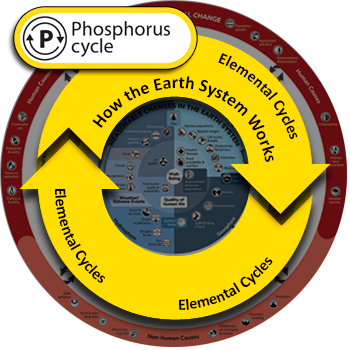The phosphorus cycle refers to the movement of phosphorus within and between the biosphere, hydrosphere and geosphere. The phosphorus cycle matters because phosphorus is an essential nutrient for sustaining life on Earth, where it plays a central role in the transfer of energy within organisms, the structure of the genetic material, and in the composition of cell membranes, bones and teeth. When other resources such as light and water are abundant, ecosystem productivity and biomass is often limited by the amount of available phosphorous. This is the primary reason we mine phosphorus, which serves as an essential component of the fertilizer used to enhance soil quality for agricultural activities.
On this page:
- What is the phosphorus cycle?
- Earth system model about the phosphorus cycle
- Explore the Earth System
- Links to Learn More
For the classroom:

Global Change Infographic
The phosphorus cycle is an essential part of How the Earth System Works. Click the image on the left to open the Understanding Global Change Infographic. Locate the phosphorus cycle icon and identify other Earth system processes and phenomena that cause changes to, or are affected by, the cycling of phosphorus.
What is the phosphorus cycle?
Phosphorus cycles through both the abiotic and biotic parts of the Earth system, especially in the biosphere, hydrosphere, and geosphere. Phosphorus is found in the Earth’s crust, primarily in sedimentary rocks that contain phosphate (PO43-) minerals. As these rocks weather and erode, dissolved phosphates enter the soil and travel via rivers to the ocean. Primary producers (photosynthesizing organisms), both on land and in the ocean, absorb the phosphate needed to produce organic compounds necessary for the survival and growth of all organisms. The phosphate acquired by organisms is returned to the soil or water through animal excretions (poop) and through the decomposition of dead organisms. Humans greatly influence the phosphorus cycle through the release of mined phosphates into ecosystems, especially in the form of fertilizers, but also from detergents and sewage waste. There are no major gaseous forms of phosphorus, so aside from wind distributing small particles of dust containing phosphorus, only very small amounts of phosphorus move through the atmosphere.

Pictured here is an algal bloom that occurred in Lake Eerie in 2011 after rains released fertilizers and sewage into the lake which are rich in phosphorus and other nutrients. Credit: NASA via USGS
Phosphorus levels can vary significantly in aquatic and terrestrial habitats, and can be affected by various human activities and environmental phenomena, including:
-

Phosphate mine in Idaho. These rocks formed around 265 million years ago where organic compounds, rich in phosphorous, accumulated in an ancient sea. Credit: GAO via USDA
The rock cycle, especially by rates of weathering and erosion. Different rock types have considerably different concentrations of phosphorus. Thus, the type of rock that is weathered plays a major role in determining the concentration of phosphorous (and other nutrients) in soils, freshwater environments, and coastal waters. The phosphorous levels, in turn, influence the biodiversity of plants and animals are present.
- Increased precipitation can increase erosion and thus increase the transport of phosphorous (and other nutrients) into soils, freshwater environments, and coastal waters.
- Deforestation, habitat loss, and erosion can reduce the nutrient levels in soils. The process of mining phosphate and the production of fertilizers also introduces pollutants into the environment, which alters habitats.
- The use of fertilizers for agricultural activities typically increases the amount of chemical nutrients in soil or water, especially phosphorous (and nitrogen). These nutrients increase plant and algae growth. However, increased nutrient is not always a good thing. For example, in aquatic environments nutrient-rich runoff can cause large numbers of algae to grow. When these algae die they are consumed by bacteria which can reduce oxygen levels in the water, killing fish and other species. This process is known as eutrophication.
- Changes in ocean circulation patterns can alter the concentration and distribution of nutrients that are transported offshore. Dissolved chemical nutrients, especially phosphorus (and nitrogen) are critical for marine organisms, including the growth of plankton and algae which form the base of most ocean food webs. When organisms die they sink to the bottom of the ocean where their nutrients are released as they decay. These nutrients can be returned to the surface by ascending currents through a process known as upwelling, which is caused by offshore winds. Regions with coastal upwelling have highly productive ecosystems because of the nutrient rich upwelled water.
- Changes in atmospheric circulation patterns can alter the concentration and distribution of dust (airborne particles) that contain phosphorous (and other nutrients) for life on land and in aquatic environments.
Earth system model about the phosphorus cycle
The Earth system model below includes some of the processes and phenomena related to the phosphorus cycle. These processes operate at various rates and on different spatial and temporal scales. For example, geologic processes, such as uplift and weathering occur over thousands to millions of years, while human influences on the phosphorus cycle happen over months to years. Can you think of additional cause and effect relationships between the parts of the phosphorus cycle and other processes in the Earth system?
Explore the Earth System
Click the icons and bolded terms (e.g. agricultural activities, soil quality, erosion, and nutrient level) on this page to learn more about these process and phenomena. Alternatively, explore the Understanding Global Change Infographic and find new topics that are of interest and/or locally relevant to you.

